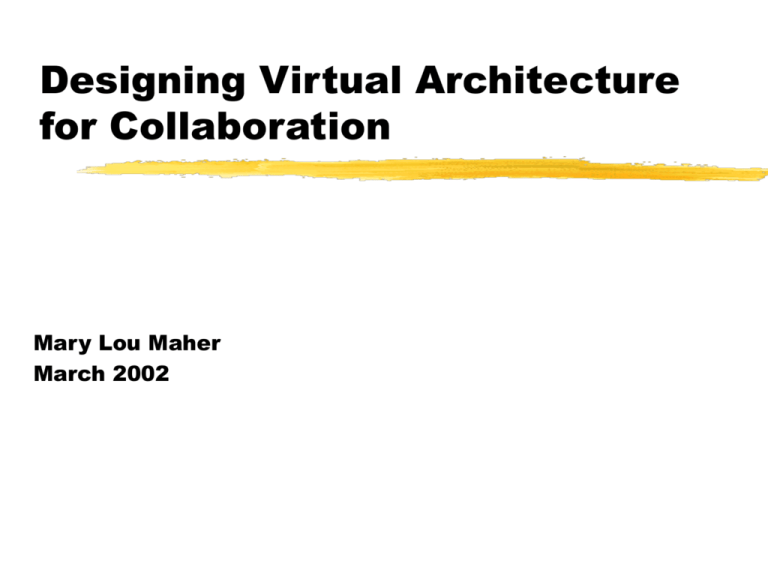Virtual Architecture
advertisement

Designing Virtual Architecture for Collaboration Mary Lou Maher March 2002 Principles of Architecture in Designing Cyberspace Spatial Enclosure Spatial Function Spatial Layout Spatial Enclosure The sense of spatial boundaries that contain people and things can create a more coherent sense of place. These spaces do not necessarily have physical boundaries. The purpose of the enclosure is to indicate the contents of the space, that is, what is in the space and what is outside the space. Spatial Enclosure Form creating Boundaries Place Awareness of others Determine basic level concepts and associated semantic frame Spatial Function Architects create different kinds of spaces for different functions. In cyberspace this may be a simple as labelling a room by its function, or more complex in defining a variety of activities and purposes for a room. In designing cyberspace, we have started with the easily identified functions of architecture, but we can go beyond this. Spatial Function Beyond form No function in form? New functions? Metaphorical reference to function Spatial Layout Architecture is non-linear. Using architectural principles in designing cyberspace has an associated non-linear topology, where navigation can follow the principles of spatial layout, or the principles of the function of the rooms. People can easily navigate among rooms and buildings without a mental map, and therefore can navigation around cyberspace without a consistent mapping to physical space. Spatial Layout Topology Dimensions: 3D: N, S, E, W, Up, Down 1D: In, Out ND: Functions Time and motion Issues in designing VA Understanding of VA as a set of objects that have both a 3D model, behaviour, and purpose Visualization of place by establishing boundaries Visualization function and purpose of place The development of a set of interactive objects that fulfill the needs in virtual architecture that are not possible in physical architecture. Consideration of the implementation of efficient virtual architecture. Two Design Examples Virtual Office and Virtual Conference room Part of our Virtual Campus Implemented in an object-oriented environment Object-oriented VA The components of the world are programmable objects Four basic classes: Room Portal Avatar Thing Virtual Office Bird View Glass Lift as the Center for Spatial Organization Virtual Office Walls as frames for holding things Virtual Office Entrance Area Providing Information & Security Devices Virtual Office Communication Area Storing Communication Tools Virtual Office Glass Lift Spatial Center Teleporting between Ground Floor & First Floor Virtual Office Working Area Providing Tools & Space for Collaborative Projects Virtual Office Relaxation Area Providing Online Entertainment Virtual Office Storage Area Storing Extra Digital Data & Function Tools Conference Facilities Walls as frames for holding things Conference Facilities Conference Room Entrance Conference Facilities Stairs to Presentation Area Conference Facilities Interior Conference Facilities Presentation Area







